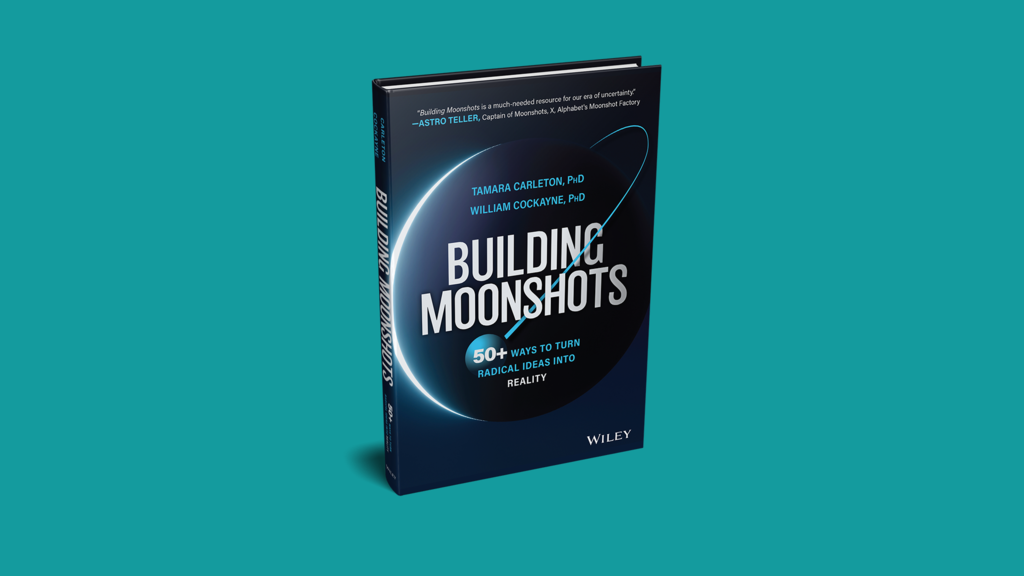
Shooting for the moon: tips for radical innovation by Tamara Carleton, PhD
Radical innovation doesn’t happen overnight. Organizations that have successfully executed moonshots adopted mindsets and strategies to get there, which can be adapted by companies and individuals looking to create real-world impact. These methods are mapped in Building Moonshots: 50+ ways to turn radical ideas into reality, a new book authored by Tamara Carleton, PhD, and William Cockayne, PhD.
MobilityXlab hosted a session for our community with the opportunity to listen to some Moonshot ways and ask questions to Tamara Carleton. An expert in radical innovation, professor, and creator of practical tools that help teams innovate, she started by sharing one of the most important characteristics of a moonshot: creating societal impact.
“I would say part of what makes a moonshot interesting is that it is more than just the technology. You've had some technical breakthroughs to get there, but these big ideas exist in a societal, economic, and human context,” she explains.
Here are some of the ways that organizations can aim for the almost impossible, and a sneak peek into the event.
I would say part of what makes a moonshot interesting is that it is more than just the technology. You've had some technical breakthroughs to get there, but these big ideas exist in a societal, economic, and human context.
Focus on the long view
It is one of the beginning ways to start talking about the near impossible and give people the model and the vocabulary to start adopting a moonshot mindset. Tamara presented a Four Horizons model from the book, which expands on the classic three-horizons model used in financial planning and consulting work, to give the organization a broader outlook across near, mid, and far time horizons.
Horizon 4 represents the visionary view, which is important for teams pursuing moonshots. “It gives you that broader north star to know where to go. When putting things together, you realize you've got four horizons that your team is working on to make something happen. This model also offers a way to consider where you might split your time and resources across horizons and then how you can be more strategic about concentrating your time and energy,” she adds.
Look for inspiration and feed curiosity
The nature of moonshots is that they take time to happen. So besides defining the four horizons and keeping the focus on the long view, it is important to look for inspiration in all horizons and also keep feeding curiosity. To Tamara, companies need to be aware of the next thing they have to look into, as it is easy to get focused only on what has to be done in the short term.
She continues: “When you're doing moonshot work, a lot of this is experimentation. There's no typical precedent, so you don't know what happened before. You're having to create the rules as you go, defining the body of knowledge and developing the skills to make it happen.”
One of the ways to tap into broader thinking is to start by asking “What if…?”. This thought exercise stimulates us to consider different future scenarios and possibilities. As a source of inspiration, she mentions the annual What-If section written by The Economist, with imaginary future scenarios and possible answers to questions that arise from them.
Foster a skunkworks culture
When asked what organizations with innovative cultures have in common, Tamara pointed out that there are several different types of Moonshot cultures, but highlighted that one of the aspects is having a skunkworks culture.
Skunkworks is a business term used to define groups working on special or advanced projects that have a high degree of autonomy. Its origins come from the pseudonym for Lockheed Martin’s Advanced Development Programs, which started in the 1940s.
But even that culture has changed, as Tamara explains: “It is inspired by the original skunkworks that came from Lockheed back in the day, but it has since evolved into describing how you have very scrappy, passionate teams working together because they believe they're making a difference.”
Building Moonshots: 50+ ways to turn radical ideas into reality will be released on May 9. For more information and pre-ordering the book (and receive special bonuses), visit the website.



